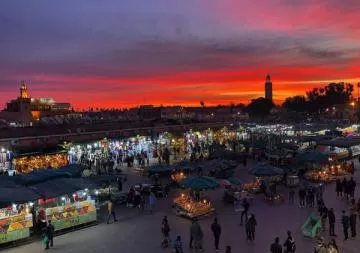Between tradition and modernity, Marrakech is the promise of incomparable sensations. Strolling through the Jemaa El-Fna square and in the souks with shimmering colors and oriental scents, the red city responds with a snap of the fingers to your desires for a change of scenery.
You can admire all the architectural richness of the Medina by visiting one of its many Riads, small oriental palaces organized around a central patio, or even recharge your batteries at the Menara, a large garden with an emblematic basin of the city. Marrakech leaves the choice to its visitors by drawing on its incredible diversity. It is enough to leave the enclosure of the ramparts to be immersed in contemporary Morocco. The Guéliz and Hivernage districts offer the most modern infrastructures, international luxury, and ready-to-wear boutiques as well as wide airy avenues; the whole in the respect of the cachet specific to Marrakech.
Jemaa-El-Fna:
The most famous Moroccan square attracts thousands of visitors every year to discover the old-fashioned charm of the place. For centuries, this court of miracles has been a real place of life for Moroccans. We observe snake charmers, acrobats, fire eaters, monkey showers but also storytellers and many other entertainers.
In the evening, small taverns are set up with tables and benches under small bulbs and offer Moroccan street food. The smoke from the itinerant restaurants at night gives the place a mysterious, even mystical atmosphere. To quench your thirst, do not hesitate to taste the excellent squeezed orange juice that can be found everywhere on the square. In short, you will understand, you have to at least spend an evening on the Jemaa El Fna square. This popular place where many small ancestral trades persist was classified in 2001 as an intangible cultural heritage of humanity by Unesco.
Madrasa Ben Youssef:
Founded in the 14th century and completely rebuilt in the 16th century, the Medersa Ben-Youssef takes its name from the neighboring mosque, in the north of the medina of Marrakech. Both Koranic University and university residence, the madrasa is one of the most beautiful monuments of the city and its fame goes well beyond the Moroccan borders. What most appeals to the madrasa are the contrast between the splendor of the courtyard where they taught and the monastic destitution of the 132 student rooms upstairs.
The courtyard is a marvel of chiseled facades typical of Andalusian Moorish art: zelliges, plasters, and cedar follow one another starting from the ground, chiseled with floral motifs and verses from the Koran. In the background, the prayer room is admirable for its ceiling, its dome, and its lace walls of plaster and chiseled and openwork stucco. Conversely, upstairs, the bedrooms would rather deserve the name of cell. Covered with bare and smooth plaster, they are a maximum of 9m2 and could, it is said, accommodate up to 4 students. During the heyday of the madrasa, up to 500 students followed courses in theology but also in mathematics, astronomy, medicine ...
Jardin Majorelle:
In 1919, the Lorraine painter Jean-Jacques Majorelle arrived in Marrakech. In search of a calm place to practice his art and to satisfy his love of botany, he acquired the garden which would bear his name in 1924 and opened it to the public in 1947. With his house-workshop of an incredibly intense blue which seems to absorb the light, the splendid garden is remarkable for its perspectives, its water features, its collection of cacti, and the variety of species it encloses. But this garden undoubtedly remains the painter's most admirable work for its atmosphere which is difficult to describe and the serenity it exudes. Acquired by Yves Saint Laurent and Pierre Bergé in 1980, it is now managed by the foundation created by the couple.
Since December 2011, Majorelle's former workshop has hosted a museum that presents the collection of Berber objects and art from Bergé and Saint-Laurent. Small but admirably arranged, the Berber Museum is a superb success: clothes, weapons, everyday objects or rituals, the Berbers (whose stronghold is located in the Moroccan Rif, in the north of the country), are true artists. We discover, among other things, a collection of beekeepers' smokers, sugar hammers for the tea ceremony, bags and richly decorated shoes, jewels and capes, rugs, boxes and bottles of kohl ... after the garden, the feast for the eyes continues.





